Quick Answer:
- The Euphrates River originates in Eastern Turkey.
- The Euphrates River originates from two tributaries, the Murat River and Karasu River. The Murat River Eastern Euphrates) starts in Eastern Turkey near Mount Ararat, while the Karasu River (Western Euphrates) originates in the Erzurum Province of Anatolia.
The headwaters of the Euphrates River are located in Eastern Turkey. The river originates from two main tributaries: the Murat River and the Karasu River. The Murat River, also known as the Eastern Euphrates, begins in Eastern Turkey near Mount Ararat. The headwaters of the Karasu River, also called the Western Euphrates, are in the Erzurum Province in the Anatolia Region. These two rivers join near the town of Elazığ to form the Euphrates River. The river then flows south through Syria and Iraq before eventually emptying into the Persian Gulf. This is the longest river in Western Asia, meandering for 1,730 miles (2,780 km). Between its headwaters and its mouth flow the waters of a historical river with a story to tell. Join us on a journey through time as we discover the river’s origin and explore the history of the Euphrates River.
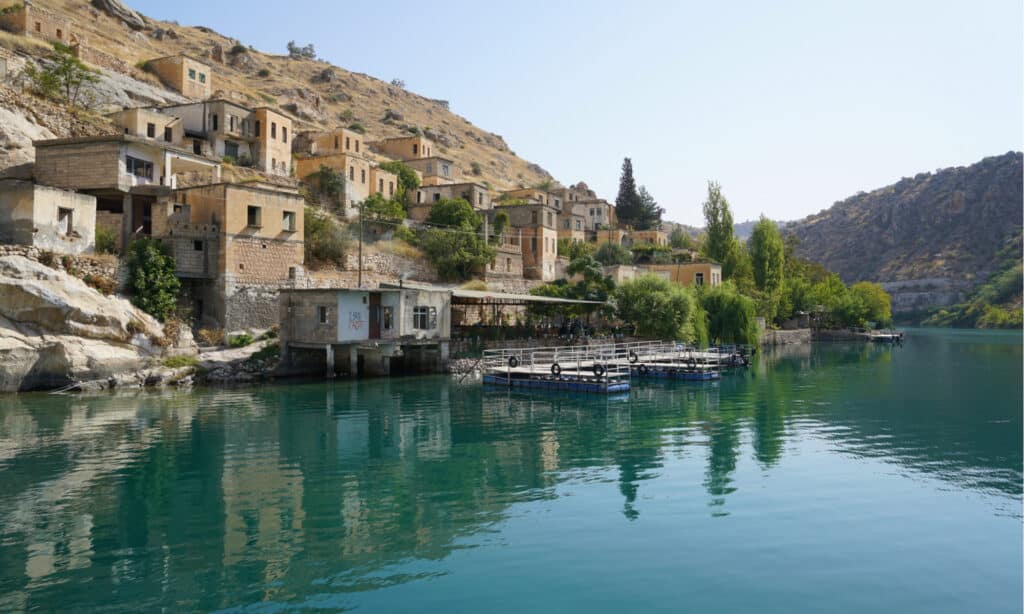
The Euphrates is the longest river in Western Asia meandering for 1,730 miles (2,780 km).
©Sadik Yalcin/Shutterstock.com
Where Does the Euphrates River Start?: History
Humans have been navigating the Euphrates River for thousands of years. The Euphrates River, the 15th longest river in Asia, has played a significant role in the history and development of various civilizations in the region. It has been a vital water source, a transportation route, and a key factor in agricultural productivity. The earliest evidence of human settlements along the Euphrates River dates to 7000 B.C. in the area between the Euphrates and Tigress Rivers called Mesopotamia. Sometimes referred to as the cradle of civilization, Mesopotamia is part of the Fertile Crescent, the area in which the earliest human civilizations developed. Located between the Tigris and Euphrates rivers, Mesopotamia is a Greek word. It translates to the land between the rivers. The land between the rivers is some of the most fecund on earth.

The earliest evidence of human settlements along the Euphrates River dates to 7000 B.C.
©Resul Muslu/Shutterstock.com
Early civilizations relied on the river for irrigation and transportation. By 2000 B.C., the Sumerians were constructing extensive canals and levees along the river to control and distribute the river’s water for agriculture. They also used boats and ships to navigate the river for trade, communication, and military purposes. The Euphrates River connected these ancient civilizations to other regions, allowing for the exchange of goods and ideas. Throughout its history, different empires including the Persians, Greeks, and Romans controlled the Euphrates River. It served as a vital transportation route, supporting the movement of people, goods, and armies. Today, the Euphrates River continues to play a vital role in the region. The Euphrates is used for irrigation, hydroelectric power generation, and transportation.
Where Does the Euphrates River Start?: River City
The Euphrates River does not have large port cities along its course. However, there are some cities located along the river that serve as important centers for trade and transportation.
Ar Raqqa is a city in Northern Syria on the banks of the Euphrates River. Ar Raqqa once served as the capital of the Islamic State of Iraq but has since been liberated. Dayr ez-Zor in Eastern Syria lies along the Euphrates River. It has strategic importance due to its location as a major crossing point over the river. Hit is an Iraqi city located on the Euphrates River. It features ancient ruins, including the famous Hit Archaeological Site.
Nasiriyah, a city in Southern Iraq, is near the Euphrates River. While it is not directly on the riverbanks, it is a major urban center in close proximity to the Euphrates. These cities are not large seaports due to the limited navigability of the Euphrates River, especially through its lower course. The Persian Gulf has major port cities such as Basra in Iraq and Kuwait City in Kuwait. However, these cities are not directly on the Euphrates.
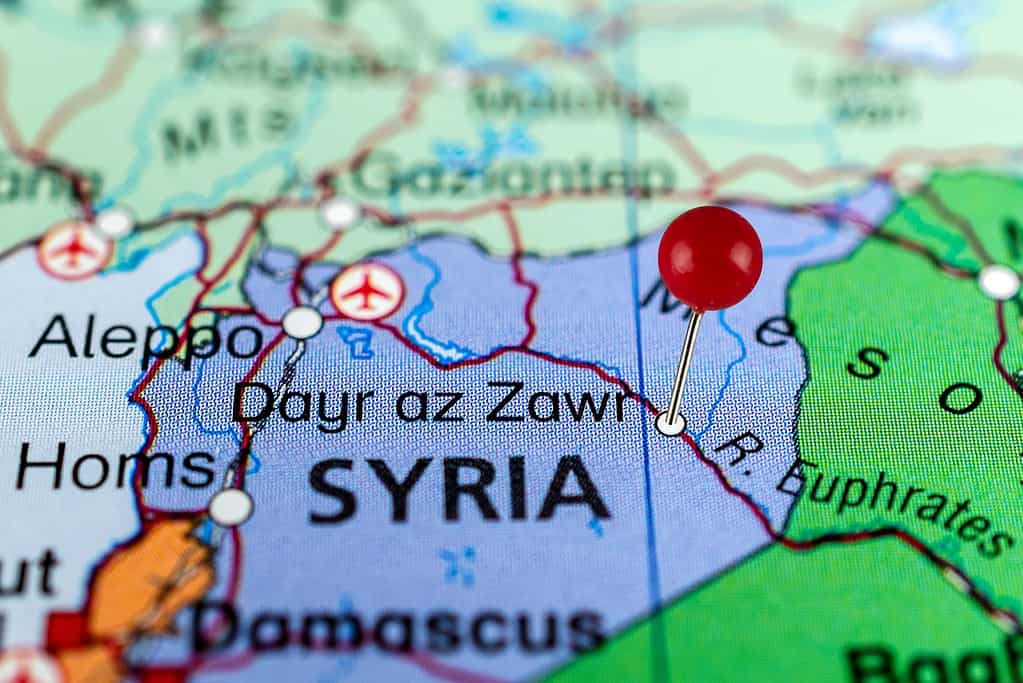
Dayr ez-Zor in Eastern Syria lies along the Euphrates River. It is a major crossing point over the river.
©PredragLasica/Shutterstock.com
Where Does the Euphrates River Start?: Dams
There are several dams along the course of the Euphrates River. These dams provide hydroelectric power, irrigation, flood control, and water storage. Located in Southeastern Turkey, the Atatürk Dam is one of the largest dams on the Euphrates River. Completed in 1990, it is the third-largest dam on Earth. The Tabqa Dam is a major dam on the Euphrates River. Opened in 1973, Tabqa Dam has been an ongoing subject of geopolitical dispute and has been the site of battles and bombings.
The Haditha Dam, located in Western Iraq is the second largest generator of hydroelectric power in Iraq. It was completed in 1987. The creation of the Haditha dam flooded the ancient archeological site of Usiyeh. In 1982-83, an archaeological expedition from Japan excavated a multi-chambered room complete with a staircase and several terra cotta lion statues at the site. The lion statues most likely date to 1700 B.C.

Completed in 1990, Atatürk Dam is the third-largest dam on Earth.
©mehmetkrc/Shutterstock.com
These dams, along with other smaller ones, have had a significant impact on water management, agriculture, and energy production in the regions through which the Euphrates River flows. The dams have provided increased agricultural productivity, electricity generation, and a regulated water supply. Dam construction and water management practices have also raised concerns related to downstream water availability, and its environmental impact.
Pollution and Water Flow
The Euphrates River faces challenges related to pollution due to various human activities. Factors such as industrial discharge, agricultural runoff containing fertilizers and pesticides, untreated sewage, and the detritus of the ongoing geopolitical strife have contributed to water pollution in certain sections of the river. Conflict and instability in the region have resulted in a lack of infrastructure maintenance and proper wastewater treatment.
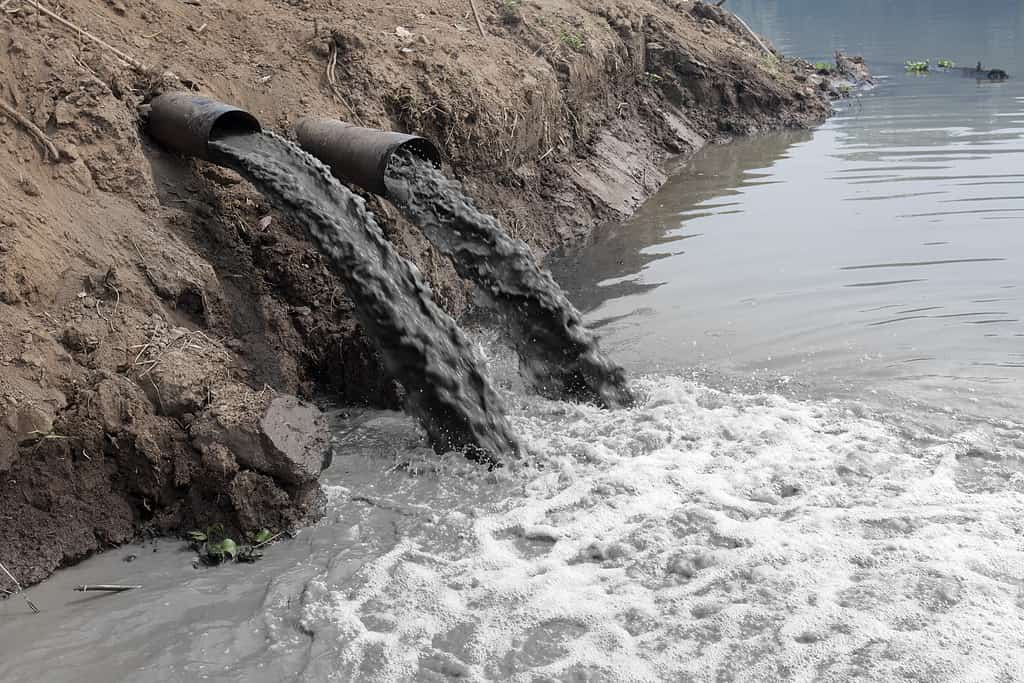
Industrial discharge, agricultural runoff, and untreated sewage have contributed to water pollution.
©Toa55/Shutterstock.com
Regional governments and organizations have made efforts to address the issue of pollution and improve the water quality of the Euphrates River. These include the implementation of environmental regulations, water treatment initiatives, and awareness campaigns. International organizations, such as the United Nations Environment Programme (UNEP), have been instrumental in these projects. Their goal is to improve water management and address pollution in the Euphrates River basin. The effectiveness of these efforts and the overall cleanliness of the river varies between different sections and jurisdictions.
Flow
While the Euphrates River has not dried up entirely, there have been reports of reduced water levels in certain sections. Especially during dry periods. The Euphrates River is experiencing changes in its water levels. There are concerns about reduced water availability in certain sections of the Euphrates. These conditions can have implications for agriculture, ecosystems, and the livelihoods of communities that depend on the river for water resources. The construction of dams and irrigation projects along its course. of the river have contributed to a reduction in water flow. These upstream projects were implemented to provide power, irrigation, and water storage. While the dams do provide these necessities to the communities upstream, they also alter the natural flow of the river, leading to reduced water downstream.
Climate change is another factor driving the lower water of the Euphrates River. Changes in precipitation patterns, increased evaporation rates, and rising temperatures have affected the river’s flow. Variations in rainfall and snowmelt in the river’s headwaters in Turkey have had an impact on the overall water supply downstream.
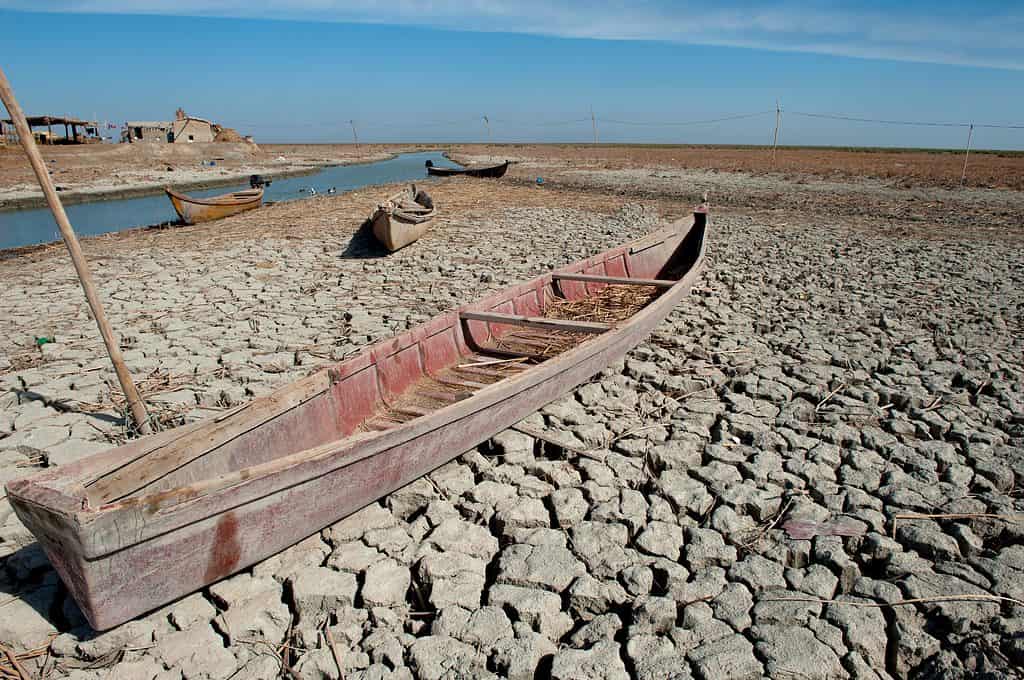
While the Euphrates River has not dried up entirely, there have been reports of reduced water levels.
©John Wreford/Shutterstock.com
Where Does the Euphrates River Start?: Wildlife
The Euphrates River and its surrounding ecosystem support a diverse range of wildlife.
The area is home to numerous bird species, including waterfowl, waders, and migratory birds. Common species include herons, egrets, storks, ducks, geese, along with various songbirds. The river provides important habitats for nesting, feeding, and resting for many avian species. The river is known for its fish populations. Species such as carp, catfish, barbel, mangar, pike, and various types of trout inhabit the river. These fish provide an important food source for both humans and other wildlife. The region is home to several reptiles. Turtles, as well as various snakes and lizards, inhabit the river’s banks and nearby wetlands.
Common mammals in the vicinity include water buffalo, wild boars, jackals, foxes, and rodents such as jerboas. The Euphrates River and its riparian areas support a variety of insects and invertebrates. These include dragonflies, damselflies, water bugs, beetles, and various species of butterflies. The river and its wetlands provide breeding grounds and ample food sources for these delicate creatures.
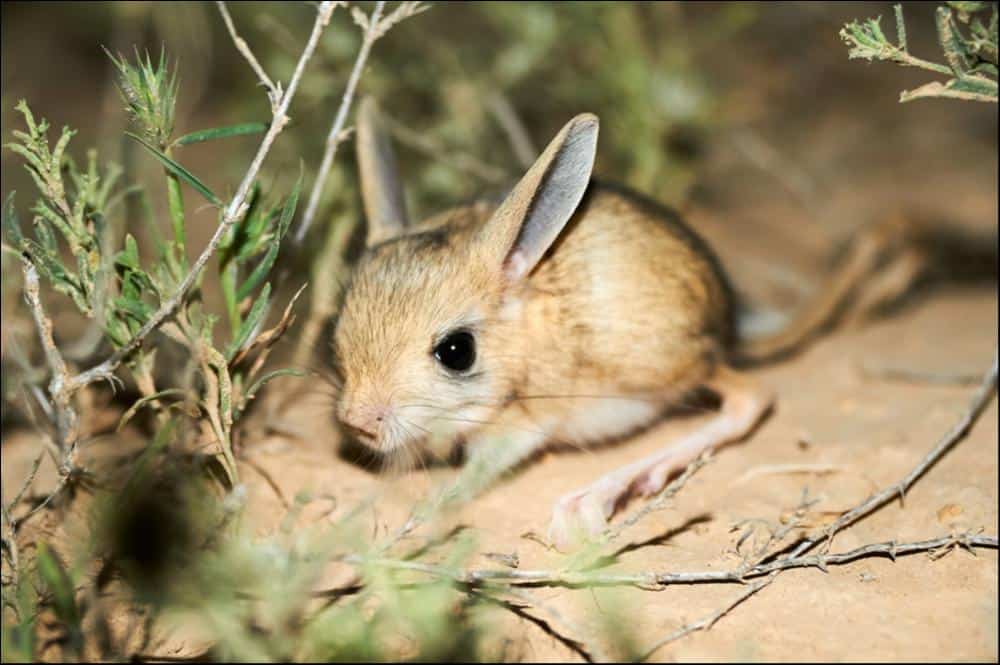
Common mammals in the vicinity include rodents like this jerboa.
©Yerbolat Shadrakhov/Shutterstock.com
Plant Life
The banks of the Euphrates River support a variety of plant life, ranging from riparian vegetation to species adapted to the surrounding arid and semi-arid environment. The specific plant species found along the banks can vary depending on factors such as climate, soil conditions, and human activities.
Tamarisk (Tamaricaceae) trees are found along the banks of the Euphrates. These deciduous shrubs or small trees have adapted to saline and arid conditions. They have feathery foliage and often grow in dense thickets.
Various species of willow trees can be found near the Euphrates River. Willows (Salix) are known for their preference for moist environments and their ability to stabilize riverbanks. They have long, slender leaves and can form dense stands. Poplar (Populus) trees, particularly the desert poplar, grow along the river’s banks.
Different species of reeds and grasses can be found growing along the Euphrates River. These plants include the common reed (Phragmites australis) and papyrus (Cyperus papyrus). Oleander (Nerium oleander), a common flowering shrub, grows along the banks of the Euphrates. It has showy, fragrant, extremely toxic flowers and leaves. Oleander is well-adapted to arid conditions.
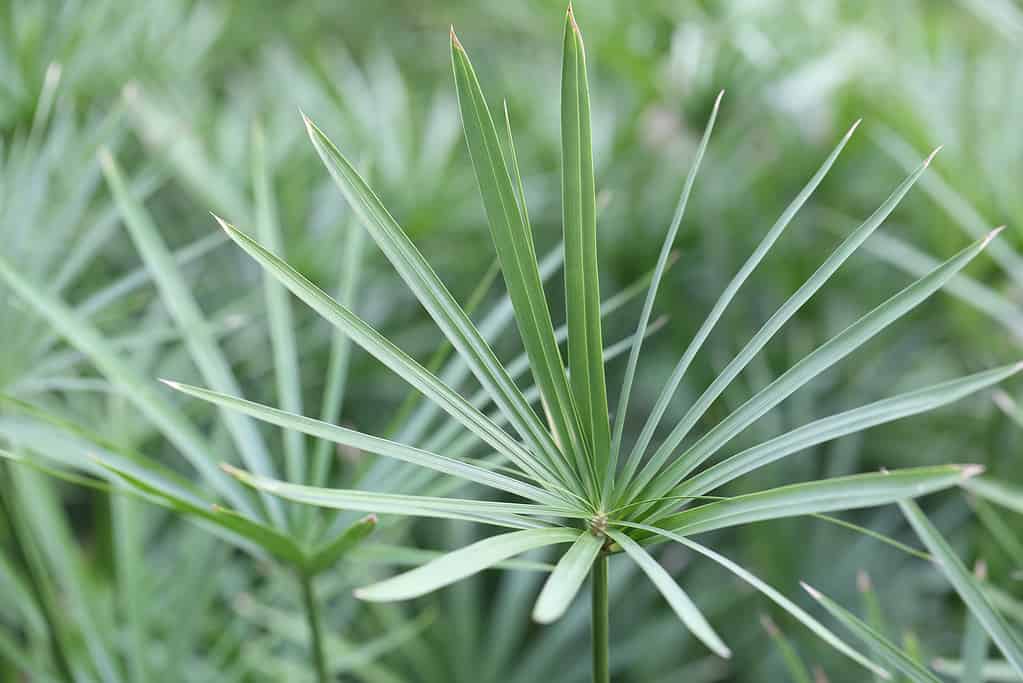
Different species of reeds and grasses can be found growing along the Euphrates River.
©Living Room/Shutterstock.com
Date palms (Phoenix dactylifera) are cultivated in many areas along the Euphrates River, particularly in Iraq. These palms provide valuable fruit and are often associated with the region’s cultural and agricultural heritage. Various wildflowers, herbs, and aquatic plants can also be found along the Euphrates River, contributing to the overall biodiversity of the region. The plant life along the river plays a crucial role in stabilizing its banks while providing habitat and food sources for wildlife.
The photo featured at the top of this post is © yunus_oz/Shutterstock.com
Thank you for reading! Have some feedback for us? Contact the AZ Animals editorial team.







